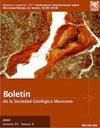伊朗中部克尔曼地区Yazdanshahr 2号剖面基于牙形石群落的生物地层学
IF 0.4
4区 地球科学
Q4 GEOLOGY
引用次数: 0
摘要
Yazdanshahr 2号部分主要由Bahram和Sibzar地层组成,位于克尔曼省北部(伊朗中部)的Zarand市。根据牙形石群落划分出5个生物带。第一个生物带包括Padehat组(15米)和Sibzar组(75米),根据Bipennatus属和Icriodus属进行了区分,并认为可能对应的年龄跨越emian到Eifelian。第二个生物带以指数分类群Polygnathus varcus首次出现为标志(varcus带:早至中Givetian)。第三个生物区开始于索引属鸢尾花的第五次出现(鸢尾花区:middle Givetian)。第四个生物带的基础是首次出现的I. subterminus属(subterminus带:Givetian中晚期),最后一个生物带是在givetin - frasnian边界首次出现的Ancyrodella属和Polygnathus in完成属(pseudoovalis to crepida Zone?从弗拉斯尼亚语到法曼尼亚语?)Bahram组(94米)下部为化石灰岩(varcus - subterminus带),上部为白云岩-砂岩(pseudoovalis - crepida带?)西扎尔组由中泥盆统白云岩和灰质白云岩组成,含砂岩和灰岩夹层。本文章由计算机程序翻译,如有差异,请以英文原文为准。
Biostratigraphy of Yazdanshahr No.2 section in Kerman area, Central Iran, based on conodont communities
Yazdanshahr No.2 section, which consists mostly of Bahram and Sibzar formations is located in the Zarand city, northern Kerman province (Central Iran). Five biozones have been identified based on the conodont community. The first biozone, which includes Padehat (15 meter) and Sibzar formations (75 meter), was distinguished based on genera Bipennatus and Icriodus and the probable corresponding age was considered to span Emsian to Eifelian. The second biozone is recognized by the first appearance of index taxon Polygnathus varcus (varcus Zone: early to middle Givetian). The third biozone starts with the firth appearance of the index genus Icriodus expansus (expansus zone: middle Givetian). The base of the Fourth biozone is recognized by the first appearance of the genus I. subterminus (subterminus Zone: middle to late Givetian) and the last biozone was distinguished with the first appearance of genera Ancyrodella and Polygnathus incompletes in the Givetain-Frasnian boundary (falsiovalis to crepida Zone?: Frasnian to Famenian?). Bahram Formation (94 meter) consists of Fossiliferous limestone (varcus to subterminus Zone) at the lower part, and alternation of dolomite and sandstone (falsiovalis to crepida Zone?) at the upper part. Sibzar Formation consists of Middle Devonian dolomite and limy dolomite containing intercalation of sandstone and limestone layers.
求助全文
通过发布文献求助,成功后即可免费获取论文全文。
去求助
来源期刊
CiteScore
1.40
自引率
12.50%
发文量
34
审稿时长
50 weeks
期刊介绍:
The Boletín de la Sociedad Geológica Mexicana is a completely free-access electronic journal published semi-annually that publishes papers and technical notes with its main objective to contribute to an understanding of the geology of Mexico, of its neighbor areas, and of geologically similar areas anywhere on Earth’s crust. Geology has no boundaries so we may publish papers on any area of knowledge that is interesting to our readers.
We also favor the publication of papers on relatively unfamiliar subjects and objectives in mainstream journals, e.g., papers devoted to new methodologies or their improvement, and areas of knowledge that in the past had relatively little attention paid them in Mexican journals, such as urban geology, water management, environmental geology, and ore deposits, among others. Mexico is a land of volcanos, earthquakes, vast resources in minerals and petroleum, and a shortage of water. Consequently, these topics should certainly be of major interest to our readers, our Society, and society in general. Furthermore, the Boletín has been published since 1904; that makes it one of the oldest scientific journals currently active in Mexico and, most notably, its entire contents, from the first issue on, are available online.

 求助内容:
求助内容: 应助结果提醒方式:
应助结果提醒方式:


